I was at the entrance into the Machu Picchu complex already at 6 o’clock in the morning. First I climbed up the path passing by the south agricultural terraces and it was on one of them that I found a good spot, sat down, relaxed and waited for the sun to rise. This is one of the things people coming here like to experience, so the terraces were full of tourists who, like me, waited for the sun’s appearance, while the site itself was mostly empty and tranquil.
The whole impression was spoiled only by some completely inconsiderate and noisy tourists, and I must say that the whole place resonated only with Italian and the American version of English. At the terrace where I sat, there was an elderly couple in front of me and a few Americans behind me. As I tried to enjoy the beautiful view I inadvertently learned everything there was ever to know about the prices of real estate in some part of Milwaukee and then a woman from that group somehow managed to draw the attention to the Incas and asked what the Europeans were doing at the time when the Incas were building Machu Picchu. The main expert for the Milwaukee real estate immediately blasted out his response: “Well, pretty much nothing!” The couple that was sitting in front of me turned backwards with astonishment on their faces, speechless and looked at the group behind my back disbelievingly. Luckily, that group soon left the spot and we, who remained there, continued to enjoy the beauty around us.
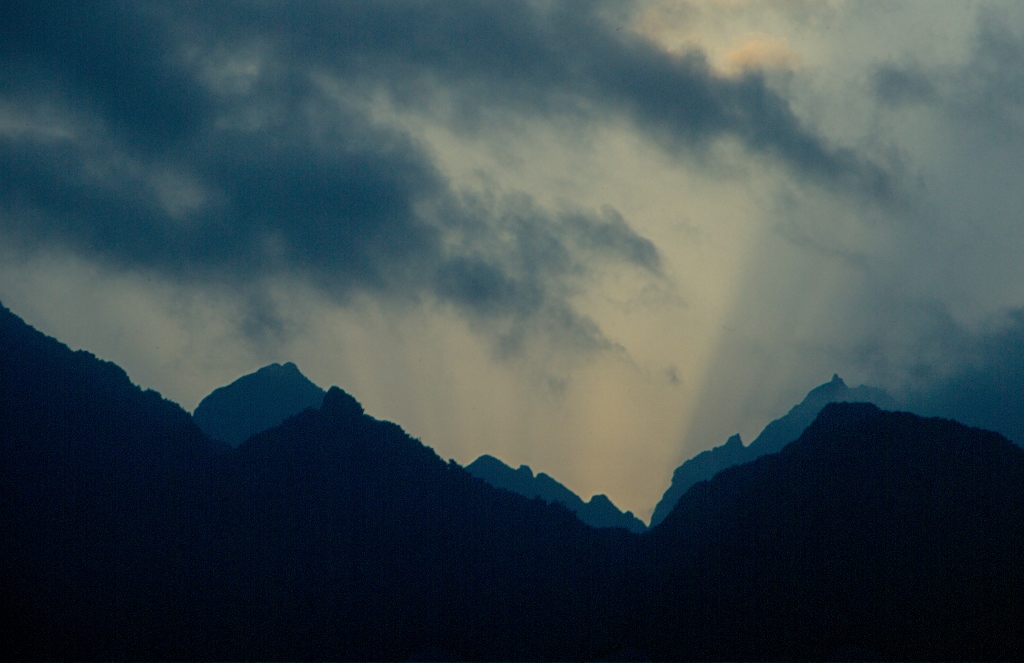 Sunrise above Machu Picchu
Sunrise above Machu Picchu
The sun eventually rose, but we were in fact already well into the day, since we actually waited for the sun to come up from behind the high mountaintops that surround the site. At one point, the couple with whom I shared the space told me that in the meantime they sent an SMS to their son back home (this was an English couple) and that they wrote to him the question and the answer that had astonished them so. The son replied to them that at the time when the Incas were building Machu Picchu, the Europeans were discovering America! We all started to chuckle at this with the pride of Europeans who shared a moment of local patriotism.
Soon I started to walk around the site and along the way I met a very nice Peruvian woman with whom I started to exchange taking of photos – she would take a photo of me and then I would take a photo of her. Thus we spontaneously continued to go around together and chatted pleasantly along the way. Her name was Paula, she was an anthropologist, worked at the Museum of the Nation in Lima and she had a keen interest in traditional medicine. When we finished our tour around the site we agreed to meet later in Aguas Calientes to have a lunch together. Namely, she was to walk from Machu Picchu down, while I opted for a bus in order to spare my recently recovered leg as much as possible.
What can I say about Machu Picchu? It will be nothing new if I say it is a truly impressive place. Its position, the mastery of its construction and fitting of buildings into the natural setting, the mystery about its true function, as well as what eventually happened to its residents – all of this contributes to the magic of the site.
As far as its position is concerned, Machu Picchu is at 2,430 m above sea level, which is almost a thousand meters lower than Cusco. The climate is mostly subtropical and there is a lot of greenery around it. The site practically lies over a mountain saddle, with high mountains from which the Inca trail arrives rising on the one side and a rocky elevation that stands out in the standard pictures of Machu Picchu, named Huayna Picchu, on the other side. Around Machu Picchu and Huayna Picchu there is a 400 m deep gorge through which runs the sacred river of the Incas, the Urubamba, that makes a very sharp loop right here. In addition to the waiting for the sunrise, one of the reasons why tourists come here so early is the possibility to climb up Huayna Picchu. The authorities allow some 400 tourists a day, since the path is steep and narrow. Even before the incident with the knee I had decided I would not climb up, so I peacefully enjoyed in what can be visited in the relatively flat terrain.
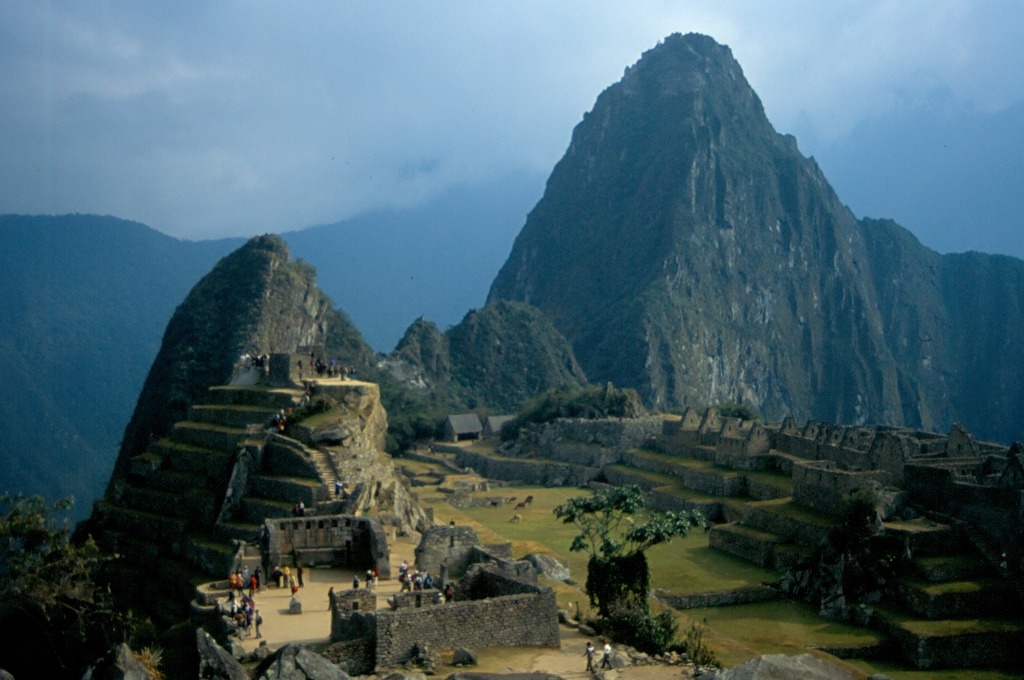 Machu Picchu. The sharp rocky elevation to the right is Huayna Picchu
Machu Picchu. The sharp rocky elevation to the right is Huayna Picchu
Basically, no one really knows what went on in Machu Picchu. Of course, there are different theories: from the idea that it was used for growing food to its being a summer palace for an Inca ruler, taking into account its lower altitude and different climate in comparison to Cusco. It is also not known why the place was abandoned. There are theories about this, too, like there was an epidemics or whatever, but then there would be mortal remains around the site, which is not the case. This essentially means that nothing is known for certain. The Incas didn’t have an alphabet in our sense of meaning, but rather they communicated through knots they made on ropes, making it very difficult to come to any concrete findings without written traces. Until 1911 when it was discovered by Hiram Bingham the place was completely overgrown in dense vegetation. Since then, a lot has been cleared up, but archaeological researches continue in different directions around the central site.
There are several significant elements within the site. One of them is the Temple of the Sun. It is the only building within the complex with a roundish base. The temple extends from a natural rock that remained within it and served as an altar. Under this building, also known as the Torreon, i.e., under the rock, there is a natural small cave, also called the Royal Tomb although no mortal remains have ever been found there. Still, it is interesting to come to this side of the building as well in order to see the great skill of the masons who took full advantage of the natural rocks, either left as they were or altered to a degree, and then adjoined using additional building elements.
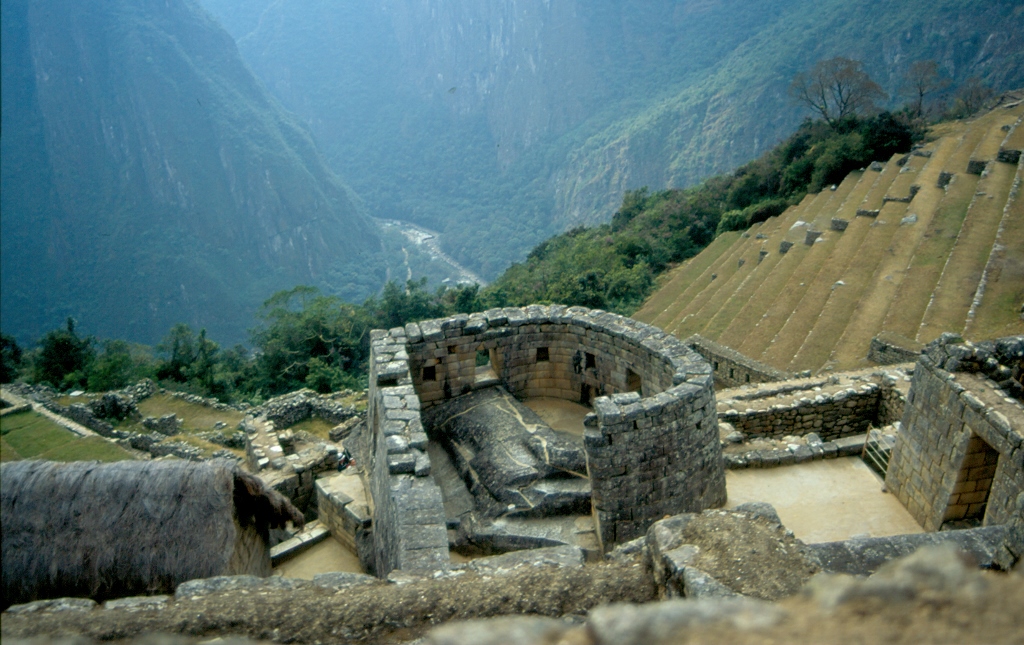 Temple of the Sun, Machu Picchu. On the right hand side are the south agricultural terraces and in the upper part there is the gorge through which the Urubamba flows from the direction of Aguas Calientes.
Temple of the Sun, Machu Picchu. On the right hand side are the south agricultural terraces and in the upper part there is the gorge through which the Urubamba flows from the direction of Aguas Calientes.
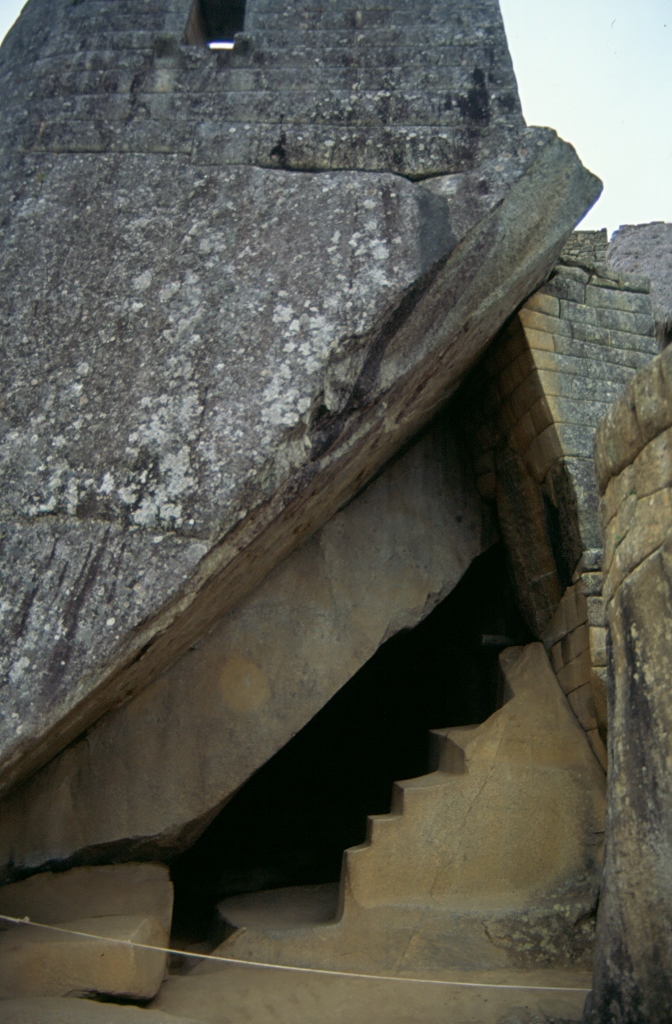 Royal tomb, Machu Picchu. On top it is possible to see the adjoined stone blocks laid over the natural rock that constitute the Temple of the Sun. At the entrance into the small cave there are stairs chiselled in the rock, while to the right from the stairs one can see very skilfully fitted building addition
Royal tomb, Machu Picchu. On top it is possible to see the adjoined stone blocks laid over the natural rock that constitute the Temple of the Sun. At the entrance into the small cave there are stairs chiselled in the rock, while to the right from the stairs one can see very skilfully fitted building addition
Not far from this point there is the Three-Windowed Temple and some other buildings, as well as the most sacred place at the site – Intihuatana. It is a holy stone laid down in line with the points of compass that was used for astronomical determining of the seasons and for different rituals. The stone is situated on top of a hillock and a number of stairs lead to it. In order to eradicate local traditions, the Spanish by the rule demolished these holy places in all the settlements they conquered. However, as Machu Picchu remained undiscovered until the beginning of the 20th century, the Intihuatana stone survived here.
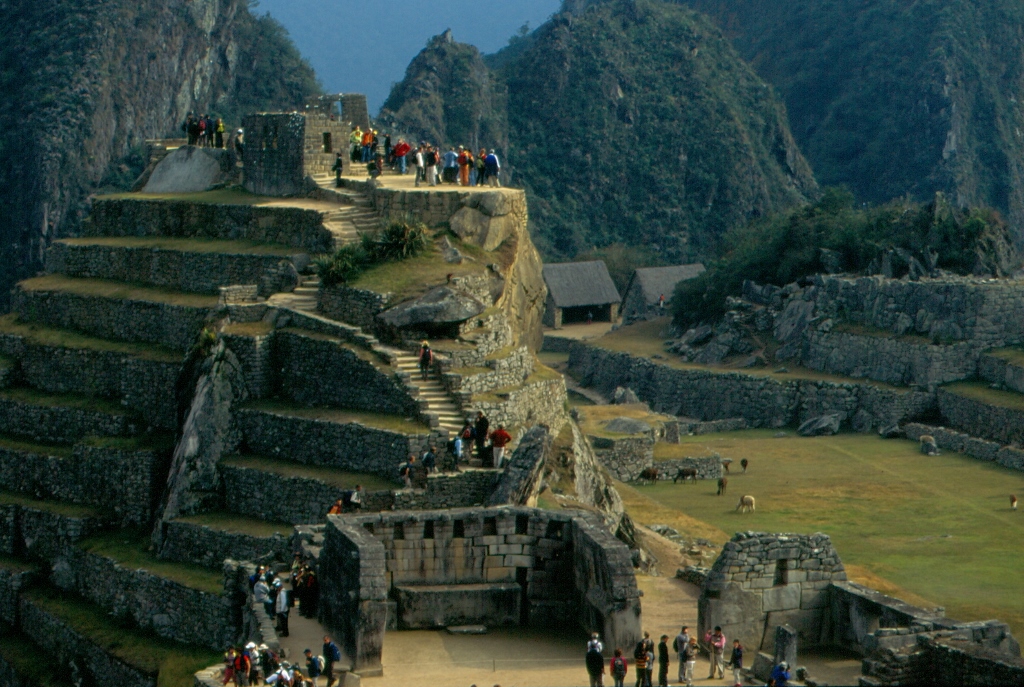 The hillock on top of which there is the Intihuatana (it cannot be seen in the picture, as it is hidden by the small “house”). The Sacred Plaza is on the right hand side.
The hillock on top of which there is the Intihuatana (it cannot be seen in the picture, as it is hidden by the small “house”). The Sacred Plaza is on the right hand side.
In addition to different buildings, the site also contains the Sacred Plaza. It is a pretty, flat and green lawn where llamas and alpacas grazed peacefully. The plaza separates the ceremonial part of the site from buildings which are presumed to have been used for housing. It needs to be said that all the buildings have trapezoid windows and openings that served as doors. As far as the building technique is concerned, there are a few places where the perfect fitting of stones can be seen, but there are also a lot of places where stones were laid down using binding material.
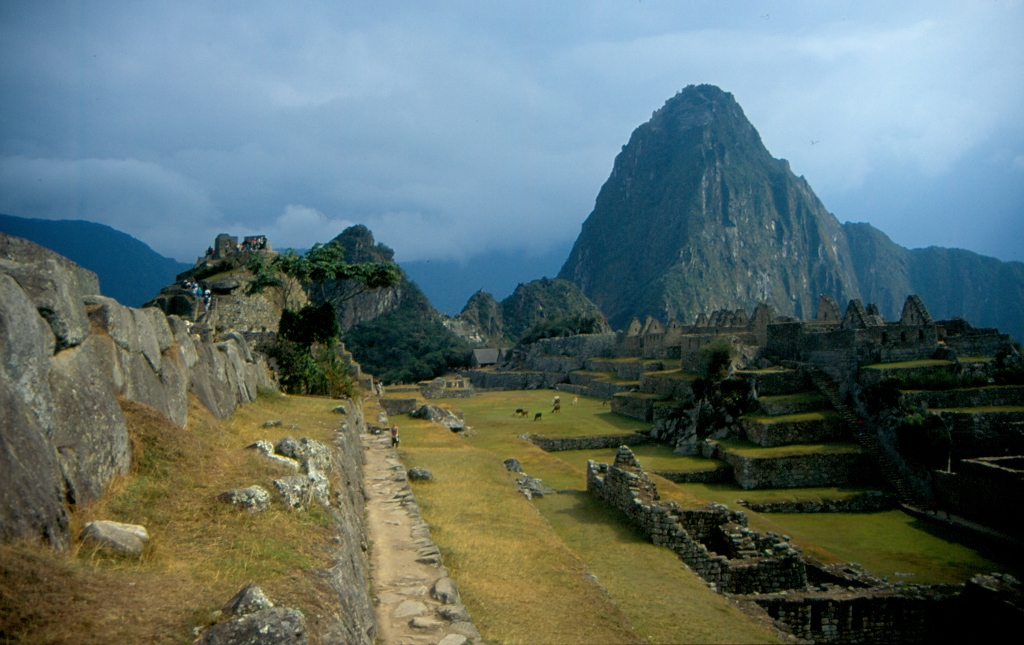 Machu Picchu: holy hillock is to the left, Sacred Plaza is in the middle, in the top left part is Huayna Picchu, while residential buildings and some terraces are to the right.
Machu Picchu: holy hillock is to the left, Sacred Plaza is in the middle, in the top left part is Huayna Picchu, while residential buildings and some terraces are to the right.
By the way, Machu Picchu has several creeks and springs, as well as a brilliantly constructed network of canals used for draining water from the site. I have already mentioned agricultural terraces. They enabled the Incas to grow different crops on the otherwise very steep slopes, thus getting very good yields and facilitating local supply.
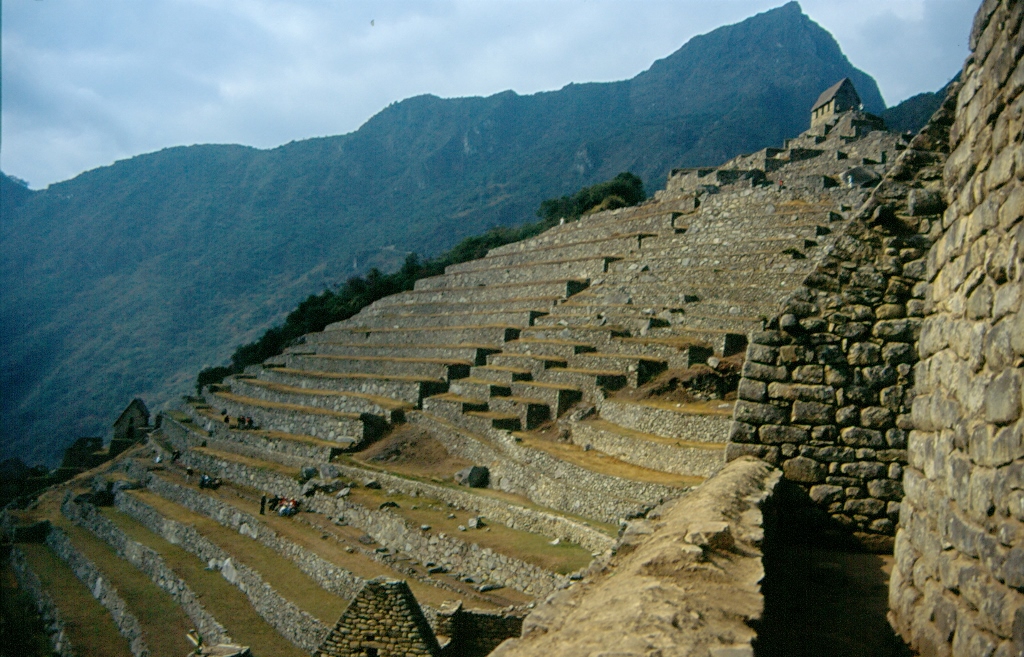 Machu Picchu: South agricultural terraces
Machu Picchu: South agricultural terraces
And thus my tour around Machu Picchu was getting close to its end. As it can be seen from the photos, the day I went up it was rather cloudy and that was another reason why I regretted not using my entry ticket the day before as well, for it was completely sunny then.
After the lunch with Paula, I got on the train. There, the tourists were treated to a folklore show with the local music coming from the train’s loud speakers. And then suddenly the same loud speakers produced music of Madonna and Kylie Minogue, and local models showed us products made of alpaca – sweaters, shawls, ponchos, etc.
When we reached Cusco it was already dark. As the train went zigzag and slowly descended towards the town, I could enjoy the views at the beautifully lit buildings and streets. Still, I had to rush and go to bed early, since the next morning I again had to get up around 5 am in order to catch a plane to Lima. I didn’t ponder too much about the way I would return to the capital of Peru, since I didn’t have much of a choice: the alternative was 35 hours of coach drive!